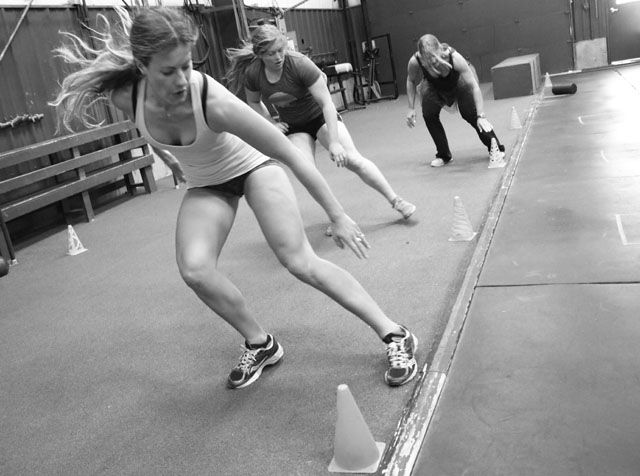By Rob Shaul
 The Dryland Ski Training Plan is a great example of the intense focus we bring to our sport-specific, pre-season training plans, and the continual evolution and improvement of our programming as we learn and grow.
The Dryland Ski Training Plan is a great example of the intense focus we bring to our sport-specific, pre-season training plans, and the continual evolution and improvement of our programming as we learn and grow.
We’re on version 4 of this plan – last updated November 2016 – based on our experience from last ski season. The plan is based on our experience working with professional Big Mountain FreeSkiers and Snowboarders here in Jackson, Wy.
Lift-assisted, alpine skiing has very specific fitness demands.
The first is eccentric leg strength. When alpine skiing, gravity “bounces” you down the hill. From a strength perspective, your legs first fight gravity from being forced into the mountain, and then pop up, out of the hole, into the next turn.
Early in my coaching career, I learned the hard way we can’t train eccentric leg strength with exercises like front squats and back squats. These train primarily “concentric” strength – the strength it takes to press out of the bottom of the squat.
For years we used our Leg Blaster complex to train eccentric leg strength. A couple years ago I replaced Leg Blasters with our Quadzilla Complex . The Quadzilla Complex is a more intense, and efficient version of Leg Blasters – where I use loading – dumbbells – to maximize its effectiveness. There is a lot of loaded hopping and jumping in Quadzillas, causing the athlete to land under the force of loaded gravity, and rapidly slow their deceleration. In this way, we train eccentric leg strength.
The second specific fitness demand of alpine skiing is what I call “Leg Lactate Tolerance” – the “burn” you feel in your quads at the end of a long ski run or at the end of a full ski day. This training plan deploys intense, Leg Lactate circuits to train your mind and body for this demand.
Each of these circuits is 2.5 minutes long – which happens to be around 30 seconds longer than a typical competition run at a Freeski competition – this is by design. Each circuit includes hops, and jumps and loaded squatting movements, as well as isometric tuck holds. See this Clip from last year to watch my pro’s fight through one of these circuits.
Finally, alpine skiing demands solid rotational, anti-rotational and extension core strength, and focused calf strength and strength endurance, and hamstring and glute medias work for balance and durability. This plan trains these also.
Progression and focus are key to the design. Simply put you’ll train eccentric leg strength Monday and Wednesdays, and Leg Lactate Tolerance Tuesdays and Thursdays, again and again for 7 weeks. Fridays and weekends are for rest. Over the 7 weeks, we “progress” the volume of the Quadzilla Complex and Leg Lactate Circuits you complete. Same thing, only harder.
This training program is specifically designed to be completed the 7 weeks directly before your ski season begins, or before a ski vacation. The Jackson ski resort opens on Thanksgiving weekend, and we’ll begin this year’s dryland cycle on October 5th.
Overall, the training plan is designed to get you to the slopes sport-specifically fit, strong and stable – so you can get the most out of your turns at the beginning of the season, or enjoy your ski vacation to the fullest.
This training plan is one of the 200+ Plans included with an Athlete’s Subscription.
Questions? Email coach@mtntactical.com
